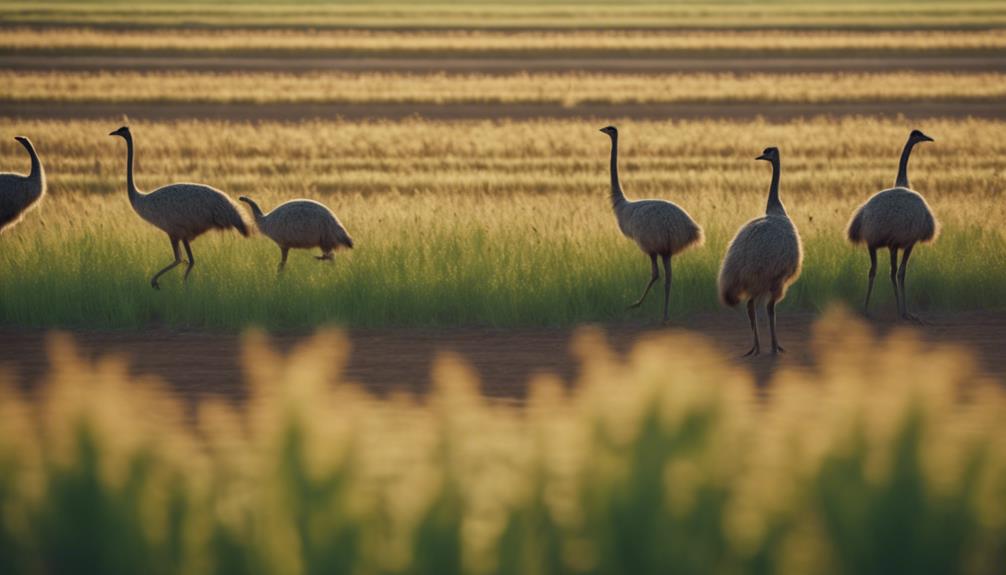
Imagine a world where a single creature could significantly impact the health and vitality of soil ecosystems. Emus, often underestimated in their role, possess unique abilities that can shape the very foundation of soil regeneration.
By exploring the intricate interactions between these flightless birds and the earth beneath our feet, a deeper understanding emerges of how emus contribute to a complex web of soil dynamics.
Intriguing insights await as we uncover the mysteries behind their influence on soil health and regeneration.
Key Takeaways
- Emus enhance soil fertility through nutrient cycling and natural fertilization.
- Emus contribute to soil structure, erosion control, and moisture dynamics.
- Emus aid in seed dispersal, promoting plant growth and biodiversity.
- Emus play a vital role in soil health by fostering microbial activity and ecological resilience.
Emus as Soil Disturbance Agents

Emus play a crucial role in soil health by actively disturbing the soil through their foraging behavior, contributing to enhanced nutrient cycling and aeration. Their unique behavior aids in soil compaction prevention as they traverse the land, preventing the soil from becoming overly compacted. By foraging for food, emus inadvertently break up the soil, allowing for better water infiltration and root growth.
Furthermore, emus assist in soil moisture retention through their foraging habits. As they move across the landscape in search of food, they disturb the topsoil, creating spaces that can trap and retain moisture. This action is particularly beneficial in arid regions where water conservation is essential for plant survival.
The disruptive nature of emus' foraging behavior not only benefits the soil directly underneath their feet but also has far-reaching effects on the overall soil health of the ecosystem. Their actions promote aeration, nutrient availability, and microbial activity, all of which are vital for maintaining a healthy and productive soil environment.
Nutrient Cycling by Emus
Enhancing soil fertility through the facilitation of nutrient cycling is a critical ecological function observed in the foraging behaviors of emus. Emu grazing plays a vital role in soil enrichment by promoting nutrient cycling. As emus forage, their feeding habits lead to the breakdown of plant material, resulting in the release of essential nutrients like nitrogen and phosphorus back into the soil. This process enhances soil fertility, making it more conducive for plant growth.
Studies have shown that areas frequented by emus exhibit higher levels of nutrient availability in the soil compared to areas without emu activity. Emus help in the dispersion of nutrients across different areas as they move around, contributing to a more uniform distribution of essential elements necessary for plant growth. Additionally, their droppings act as a natural fertilizer, further enriching the soil with organic matter and nutrients. Emu grazing, therefore, plays a crucial role in nutrient cycling, ultimately benefiting the overall health and productivity of the ecosystem.
Emus' Impact on Soil Structure

The physical properties of soil, including its texture and stability, are significantly influenced by the presence and foraging activities of emus in the ecosystem. Emus play a crucial role in shaping soil structure through their behaviors and interactions with the environment. Here's a closer look at how emus impact soil structure:
- Soil Compaction: Emus' movement and weight exert pressure on the ground, affecting soil compaction levels. Their wandering and foraging can lead to both positive and negative effects on soil density, influencing water infiltration and root growth.
- Soil Moisture: Emus' foraging activities disturb the topsoil, exposing it to environmental elements. This disturbance can impact soil moisture levels, affecting plant growth and microbial activity. Understanding how emus alter soil moisture dynamics is essential for ecosystem management.
- Structural Integrity: By modifying soil compaction and moisture content, emus contribute to the overall structural integrity of the soil. This, in turn, influences nutrient availability, water retention, and plant productivity in the ecosystem.
Seed Dispersal by Emus
Seed dispersal within ecosystems is a critical ecological process influenced by various factors. When it comes to emus, these large birds play a significant role in seed dispersal, aiding in the ecological benefits of nutrient cycling within their habitats. Emus consume a variety of fruits, seeds, and vegetation, and as they move across the landscape, seeds pass through their digestive system relatively intact. The seeds are then dispersed through their droppings, often far from the parent plant, facilitating plant colonization in new areas. This process not only helps in the natural regeneration of vegetation but also enhances biodiversity within the ecosystem.
Through the seed dispersal activities of emus, a diverse range of plant species can establish themselves in different locations, contributing to the overall health and resilience of the ecosystem. This movement of seeds by emus supports nutrient cycling by promoting the growth of various plants, which in turn enriches the soil and sustains the intricate web of life within the environment.
Emus and Soil Aeration

Emus contribute significantly to soil aeration through their foraging behavior and movement patterns, impacting the physical properties of the soil.
- Break up Compaction: By walking and foraging across the land, emus help break up soil compaction caused by heavy machinery or livestock, allowing for better root growth and nutrient uptake.
- Enhance Water Infiltration: The emus' constant movement on the soil surface creates small holes and cracks, improving water infiltration rates and reducing surface runoff, which can help prevent erosion and loss of topsoil.
- Promote Microbial Activity: Through their actions, emus disturb the soil layers gently, promoting microbial activity that aids in nutrient cycling and decomposition processes, ultimately enhancing soil fertility.
Emus play a vital role in maintaining soil health by aerating the soil, which in turn improves its structure, water-holding capacity, and overall productivity. Their natural behaviors contribute to a healthier soil ecosystem, making them valuable allies in the quest for sustainable land management practices.
Emus' Contribution to Biodiversity
An integral aspect of maintaining biodiversity in ecosystems involves understanding and appreciating the role that emus play in supporting a diverse range of flora and fauna. Emus contribute significantly to habitat diversity, which is crucial for ecosystem balance. By foraging on a variety of plants and seeds, emus help in plant regeneration by dispersing seeds across different areas as they move, promoting the growth of a wide array of plant species. This, in turn, creates a more diverse habitat that supports various wildlife interactions, including providing food and shelter for different animals.
Emus play a vital role in shaping the landscape through their feeding habits and movements, which can impact the distribution of plant species and influence the overall biodiversity of an area. Their presence contributes to the richness of ecosystems by enhancing plant diversity and creating opportunities for diverse wildlife interactions. Understanding and preserving the role of emus in biodiversity conservation is essential for maintaining healthy and resilient ecosystems.
Emus and Soil Fertility

Regular grazing by emus significantly enhances soil fertility through their nutrient-rich droppings, positively impacting the overall ecosystem balance. Emus play a crucial role in soil health by contributing to:
- Composting: Emus help in the breakdown of organic matter through their droppings, aiding in the creation of nutrient-rich compost that enriches the soil and supports plant growth.
- Soil pH Balance: The alkaline nature of emu droppings can help regulate soil pH levels, creating a more favorable environment for beneficial microorganisms and enhancing nutrient availability to plants.
- Mycorrhizal Associations and Soil Moisture Retention: Emus promote mycorrhizal associations in the soil, which improve nutrient uptake by plants. Additionally, their foraging behavior can help aerate the soil, increase water infiltration, and enhance soil moisture retention, crucial for sustaining plant life during dry periods.
Emus' Role in Erosion Control
Enhancing soil stability and minimizing erosion risks, the presence of emus in an ecosystem offers valuable contributions to erosion control mechanisms. Emus play a crucial role in erosion prevention by trampling and compacting the soil, which helps in reducing soil erosion caused by water runoff and wind. Their constant movement and foraging behavior disturb the soil surface, breaking down compacted soil layers and promoting better water infiltration. This disturbance also aids in the incorporation of organic matter into the soil, enhancing its structure and reducing the likelihood of erosion.
Furthermore, emus contribute to land rehabilitation efforts by creating micro-depressions in the soil while foraging. These depressions act as natural water catchments, promoting water retention and reducing surface runoff. This process helps in replenishing groundwater levels and maintaining soil moisture, which is essential for plant growth and overall ecosystem health. Therefore, the presence of emus in an ecosystem not only aids in erosion prevention but also plays a significant role in land rehabilitation efforts, making them valuable contributors to soil health and regeneration.
Emus' Influence on Plant Growth

Emus significantly impact plant growth through their foraging behavior and soil disturbance activities, fostering a conducive environment for vegetative development. When it comes to plant growth, the influence of emus is profound and multifaceted. Here are three key ways in which emus affect plant development:
- Plant Diversity: Emus play a crucial role in enhancing plant diversity through their foraging habits. By selectively feeding on certain plant species, emus prevent the dominance of a single plant type, allowing for a more varied and resilient plant community to thrive.
- Root Development: The presence of emus leads to improved root development in plants. As emus move across the landscape, they disturb the soil, promoting better root growth and nutrient uptake for surrounding vegetation. This enhanced root development results in stronger, healthier plants.
- Soil Aeration: Through their constant movement and foraging activities, emus help aerate the soil. This aeration allows for better water infiltration, root penetration, and overall soil health, creating optimal conditions for plant growth and productivity.
Emus and Microbial Activity
Emus' presence in an ecosystem influences microbial activity in the soil, impacting crucial processes that underpin soil health and ecosystem functioning. Emu grazing behavior plays a significant role in shaping the soil microbial community by altering nutrient availability, organic matter decomposition, and carbon sequestration processes. This, in turn, affects microbial diversity and the interactions within the soil biota. Emus' foraging activities disturb the soil, promoting aeration and nutrient mixing, which can enhance microbial metabolism and diversity. Additionally, the deposition of emu feces introduces organic matter and nutrients into the soil, providing nourishment for various microorganisms. The table below summarizes the key aspects of how emus interact with soil microbial activity:
| Emus and Microbial Activity |
|---|
| Influence carbon sequestration |
| Impact microbial diversity |
| Alter soil nutrient availability |
| Enhance organic matter decomposition |
| Promote soil biota interactions |
Emus' Connection to Regeneration

In the context of ecosystem dynamics, the contribution of emus to soil regeneration is a critical factor to consider. Emus play a significant role in the ecological processes that lead to soil health and regeneration. Here are three key points to help you understand the importance of emus' connection to regeneration:
- Emus' Symbiotic Relationships: Emus have symbiotic relationships with various plant species, particularly in arid regions. Through their foraging habits, emus help disperse seeds across landscapes, promoting plant growth and biodiversity, which in turn contributes to soil health and regeneration.
- Emus' Ecological Resilience: Emus are well-adapted to a range of environmental conditions, showcasing their ecological resilience. Their ability to thrive in diverse habitats means they can play a consistent role in soil regeneration processes, even in challenging environments.
- Impact on Soil Erosion: Emus' movements and foraging behaviors can help prevent soil erosion by breaking up compacted soil, allowing for better water infiltration and promoting the growth of vegetation that stabilizes the soil structure. This direct impact on soil erosion contributes to overall soil health and regeneration.
Emus' Long-Term Soil Benefits
Considering the long-term impact of emus on soil health and regeneration, their consistent presence in ecosystems is instrumental in fostering sustainable soil benefits. Emus play a crucial role in soil enrichment through their foraging habits and movement patterns. As these large birds roam the landscape, they disturb the soil, aiding in aeration and breaking down organic matter. This disturbance promotes nutrient cycling and microbial activity, ultimately enhancing soil fertility over time.
Emus' impact on ecological restoration is notable, particularly in arid regions where soil degradation is a pressing issue. By creating small disturbances in the soil through their feeding and movement, emus contribute to the breakdown of compacted soil layers and the incorporation of organic material into the topsoil. This process helps improve water infiltration and retention, crucial for sustaining plant growth and overall ecosystem health.
Through their long-term presence in various habitats, emus facilitate the gradual but significant improvement of soil structure and fertility, highlighting their importance in promoting sustainable soil benefits and supporting ecosystem resilience.
Frequently Asked Questions
How Do Emus' Grazing Habits Affect the Diversity of Plant Species in an Ecosystem?
When emus graze, their foraging behavior influences plant diversity by shaping ecosystem balance. Grazing impacts the variety of plant species present, affecting the overall composition and health of the ecosystem.
Can Emus Contribute to the Prevention of Soil Compaction in Agricultural Fields?
As you ponder soil aeration and compaction prevention, consider how Emu impact could benefit agricultural fields. Their natural behavior of grazing and moving may aid in reducing soil compaction, fostering healthier soil for growth.
Do Emus Play a Role in Controlling Invasive Plant Species Through Their Foraging Behavior?
In your exploration of emus, consider their foraging impact on plant diversity. Emus may aid in controlling invasive species through selective grazing. Additionally, their role in preventing soil compaction in agriculture could contribute to ecosystem health.
How Do Emus Interact With Other Wildlife Species in the Ecosystem, and What Impact Does This Have on Overall Soil Health?
When emus interact with other wildlife species, their predation dynamics influence the ecosystem. These interactions can impact soil health through the modulation of soil microbiome interactions. Understanding these relationships is crucial for holistic ecosystem management.
Can Emus Help Restore Degraded Soils in Arid or Desert Environments, and if So, What Specific Mechanisms Are Involved in This Process?
You might be surprised to learn that emus, through their unique digestive system, play a vital role in soil health restoration. Emu dung fertilization enhances soil fertility, while their interactions with the soil microbiome promote nutrient cycling and overall ecosystem resilience.
Conclusion
In conclusion, emus play a vital role in soil health and regeneration through their unique behaviors and interactions with the environment.
Their actions as soil disturbance agents, nutrient cyclers, and seed dispersers contribute to the overall resilience and productivity of ecosystems.
Like a symphony conductor directing each instrument to create a harmonious melody, emus orchestrate a beautiful dance with the soil, fostering growth and regeneration for generations to come.




